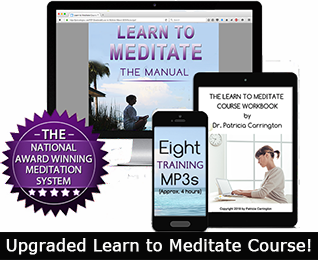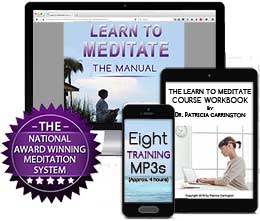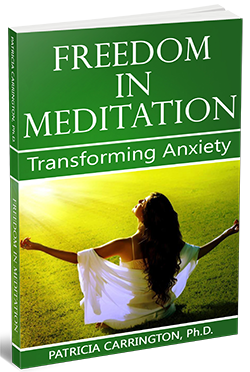How do you find time to meditate when you have a busy schedule? Dr. Patricia Carrington shares important considerations and information on mini-mediations to help you fit meditation into your busy lifestyle.
Play Audio (Duration: 11 minutes 39 seconds)
How to Fit Meditation Into a Busy Lifestyle
This audio clip is excerpted from Dr. Patricia Carrington’s Learn to Meditate Course
For many people, establishing a meditation program means trying to fit meditation into an extremely busy, crowded day where they may be on the go from morning till night. I often hear people say I get so much out of meditation. It’s so wonderful I feel like a different person when I’m doing it, but I can’t find the time to do it.
When somebody tells me this, to me, it’s as though they were saying, I can’t breathe because I don’t have time to breathe, or I can’t eat because I don’t have time to eat, or I can’t sleep because I simply don’t have time to sleep. But there are some things in life that we have to do because they’re essential, they’re necessary, and we have no vote in the matter.
In many ways, what meditation gives to us, which is a deep, inner rest, is essential for our health and well-being. We need the refreshment and the rejuvenation of that inner rest. And we need it periodically throughout the day.
The problem is that we don’t realize this and the reason lies in our society,. what we’ve been taught. Not only do we move at such a fast pace today, that’s never been known before in history, but this pace is speeding up. It’s increasing at an alarming rate. And less and less value is placed on time for oneself, time to recharge the biological battery on which we run. Our modern world places very little attention and what I call, “open time,” time that gives us the nourishment, the refreshment, the energy, to keep going.
Meditation is a superb way of recharging a biological battery, of rejuvenating our system, of re-energizing ourselves. If we’re not using meditation, or some other pause that can refresh our inner self, then we’re letting ourselves down and we’ll run into a stalemate, and into burnout, and this will create both emotional and physical problems. And, it will also take away the joy of life.
It doesn’t work for us to neglect that pause that allows us to turn inward the only problem is that we don’t really believe this and the reason we don’t, is that from every direction our society keeps urging us to keep going, no matter what. Keep doing; if you get twice as much done today, as yesterday, that’s better, so the thinking goes. And if you can get three times as much done tomorrow, as today, that’s even better. Every day of our lives, many of us avoid blame by keeping going, continuously, and that way we get approval from our families, from our community, from our employers, or from whoever we deal with. You get approval for keeping going. The pressure is on us to keep moving at all times.
On this tape, I’m going to suggest to you a different way of looking at your everyday life. It is based on what is known in science as the “Rest -Activity Cycle.” Some years ago Dr. Nathaniel Kleitman, who was a physiologist at the University of Chicago, discovered an interesting fact. Kleitman found that all warm-blooded animals naturally alternate periods of rest with periods of activity throughout the day. And that they do this in a very regular fashion, a very predictable fashion.
He called this pattern the “Basic Rest-Activity cycle.” And then, in a series of studies, he and his graduate students demonstrated that all species of animals display this rest activity pattern, and that the length of the cycles for each species is entirely different.
If you’ve ever watched pets, such as dogs and cats, you’ve seen these cycles in operation. The dog, or the cat, will rush around being very active, be foraging, or playing, or stalking. And then, suddenly, they will settle down, without hesitation, to the most contented and peaceful period of rest. And then, after they’ve rested, they’re up and ready to go again. Cats will take their famous catnaps during their rest periods. Or, they’ll sit, curled up, purring contentedly, absolutely at rest, just after having been in full action a few minutes before.
The cat doesn’t view this as contradictory behavior. It doesn’t feel that by resting it’s shirking its responsibilities as a predator. The animal is simply following its own nature, which says, to them, “rest after you’ve been active for a while, and be active after you’ve rested for a while.” For the animal, it’s a simple matter.
I remember how my wonderful Welsh corgi dog, Jaffe, would intersperse periods of wild play with shorter periods, where she’d lie still, chewing dreamily on a rawhide bone. She would munch on that rawhide toy in a slow, rhythmic manner, and she would have what I can only describe as a “distant, meditative look in her eyes. To me, this rest period was Jaffe’s equivalent of meditation. It was, in a sense, a form of natural meditation. At this time, her system went into idling gear, and she recouped energy and alertness for her next episode of active running around.
Now, strange as it may seem, human beings are no exception to the rest-activity rule, which is dictated by our biology. We too, if we’re left to our own resources and not pressured by external demands, which of course is very seldom, will naturally alternate rest and activity throughout the day. And, we will do this in a rhythmic and predictable manner.
Some interesting research, which I talked about in detail in my book, which is called The Book of Meditation, has shown that the adult human being naturally follows a rest activity cycle of about 90 to100 minutes if they’re not pressured to do otherwise. Of course, in our everyday life we are pressured to do otherwise. We’re pressured to keep going continuously.
Now this means that for about an hour-and-a-half the undisturbed person is active, and goal-directed, and focused and they accomplish many tasks and get a lot done during that time. And then, suddenly, and without warning, just the way an animal in its natural habitat does, the person will lapse into a relaxation period where they tend to daydream, to indulge in fantasy thought, to hum to themselves, or engage in idle talk, or chew on morsels of food which they pop into their mouth. During this quiet period, which lasts for about 15 to 20 minutes each time, for all intents and purposes, the person is in idling gear. In a sense, they are in a meditative mood. Then, after this rest, they automatically switch into high gear again, without any urging. Now they concentrate well, they’re very energetic, they get things done.
But, although, that’s what we do naturally when we’re not pressured to do otherwise, in today’s world, human beings are the only species on earth that observes 17 hours of uninterrupted wakefulness every day. No other animal does this. No other species fails to take regular, periodic rest breaks during their waking life, unless of course, they were in a state of emergency, in which case all animals try to keep going indefinitely. We human beings, however, operate as though we were in a state of emergency for the entire duration of our waking life. The exception is the practice of taking a siesta in certain countries. This, of course, is very healthy, because it does come a bit closer to honoring our natural rhythms.
We can schedule very short rest periods of one or two or three minutes at a time, which is exactly the time a Mini Meditation takes. And, these have a surprising ability to be both freeing and energizing at the same time. This is the reason why I consider a Mini Meditation program to be one of the most important aspects of a meditation practice.
If you’re like the rest of us, your everyday life is deeply affected by the whirlwind pace of our society. Mini Meditations are one of the most effective ways to cope.
To do them, you sit quietly, usually with eyes open, gazing at some pleasant object, which can be as simple as a plant on your desk, a wall painting, or a carpet on the floor. While you sit quietly, repeat your special sound, your Mantra, to yourself silently. And, no one else knows that you’re meditating. This simple procedure brings a sense of a mini-vacation, of being wafted away momentarily to some faraway place, and then brought back again, refreshed.
When you get into the habit of using Mini Meditations in the way described in your booklet you’ll not only feel restored and at ease, but you’ll be able to watch your efficiency and your competency increase as a result. In your booklet, you’ll find complete instructions for using Mini Meditations. They’re in Section Four, “Helping Meditation Work,” under the heading, “Mini Meditation Stress Control Program.”
This section of the booklet shows you how to scatter Mini Meditations throughout your day, so that you won’t work longer than an hour and a half, at any point, without taking a mini break to recharge your battery.
In the booklet, I suggest one hour as ideal between Mini Meditations. Following the simple program, as it’s outlined there, will work wonders for relaxing your mind and body, and interestingly enough, at the same time, it can improve the productivity of your work.
 This easy-to-follow instruction kit contains downloads of the 8 audios, plus the Learn to Meditate Manual (PDF) and the Interactive PDF Workbook. Using this method you can master meditation within a week and feel its powerful effects at once. See complete details…
This easy-to-follow instruction kit contains downloads of the 8 audios, plus the Learn to Meditate Manual (PDF) and the Interactive PDF Workbook. Using this method you can master meditation within a week and feel its powerful effects at once. See complete details…






